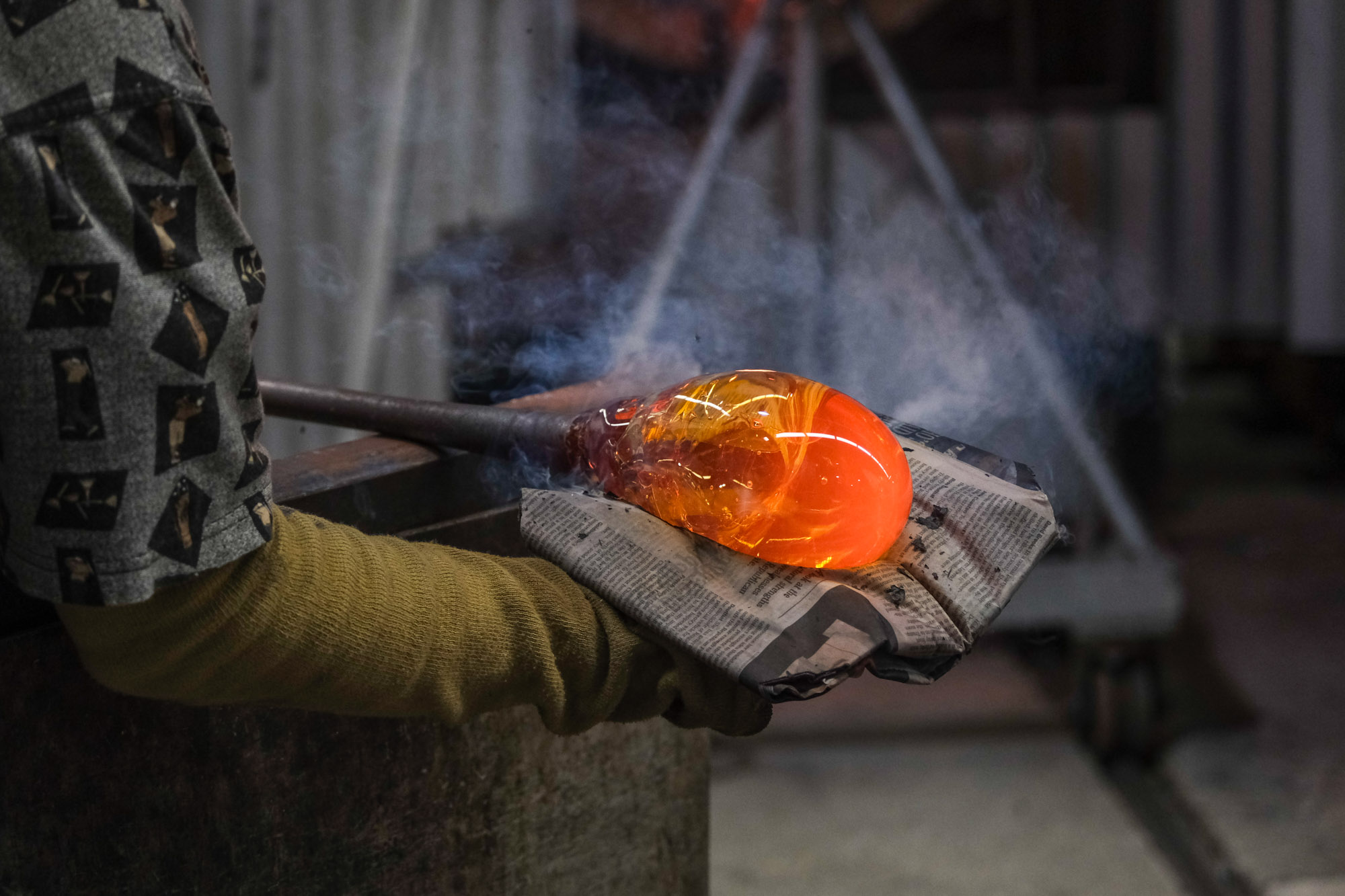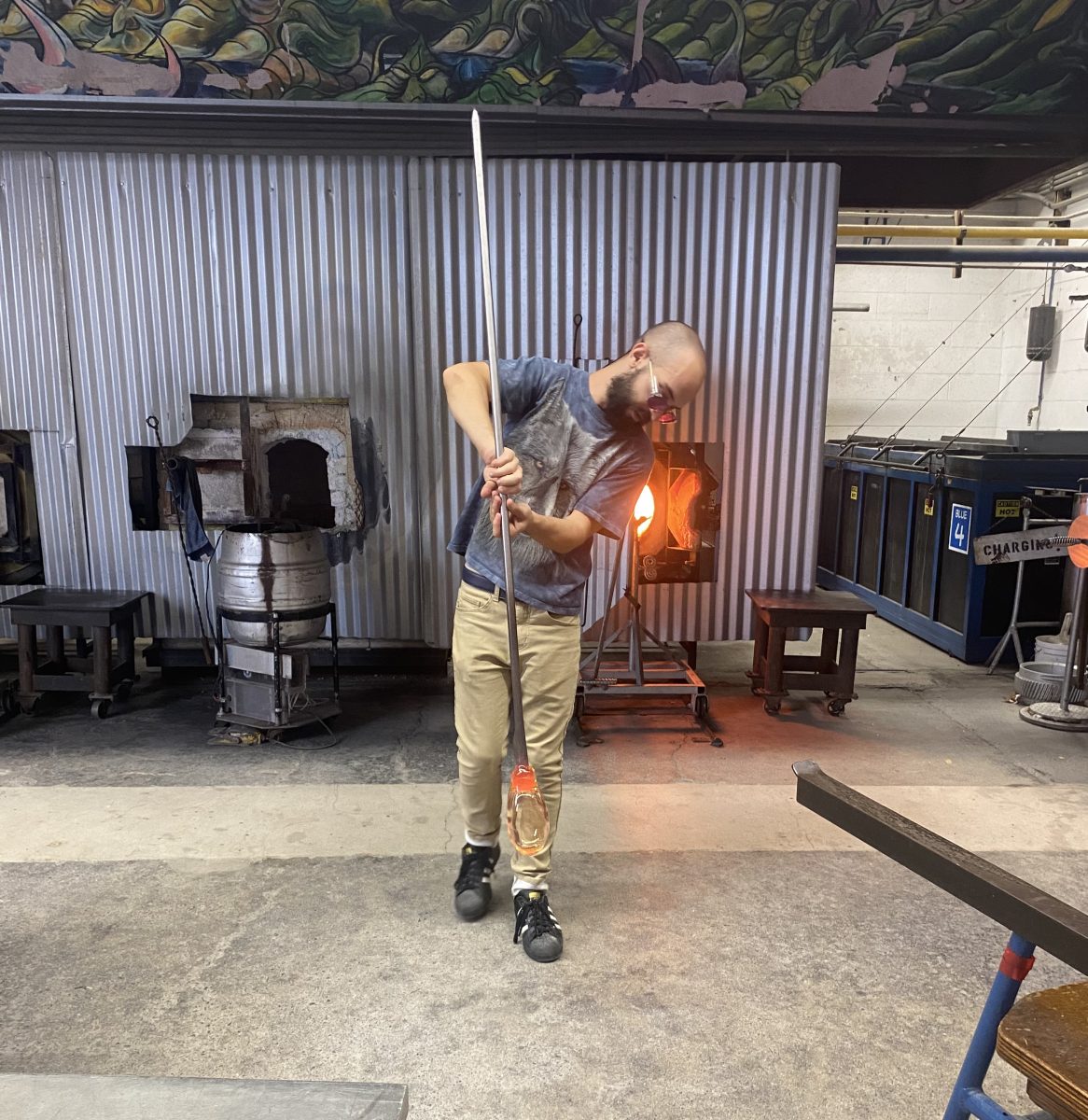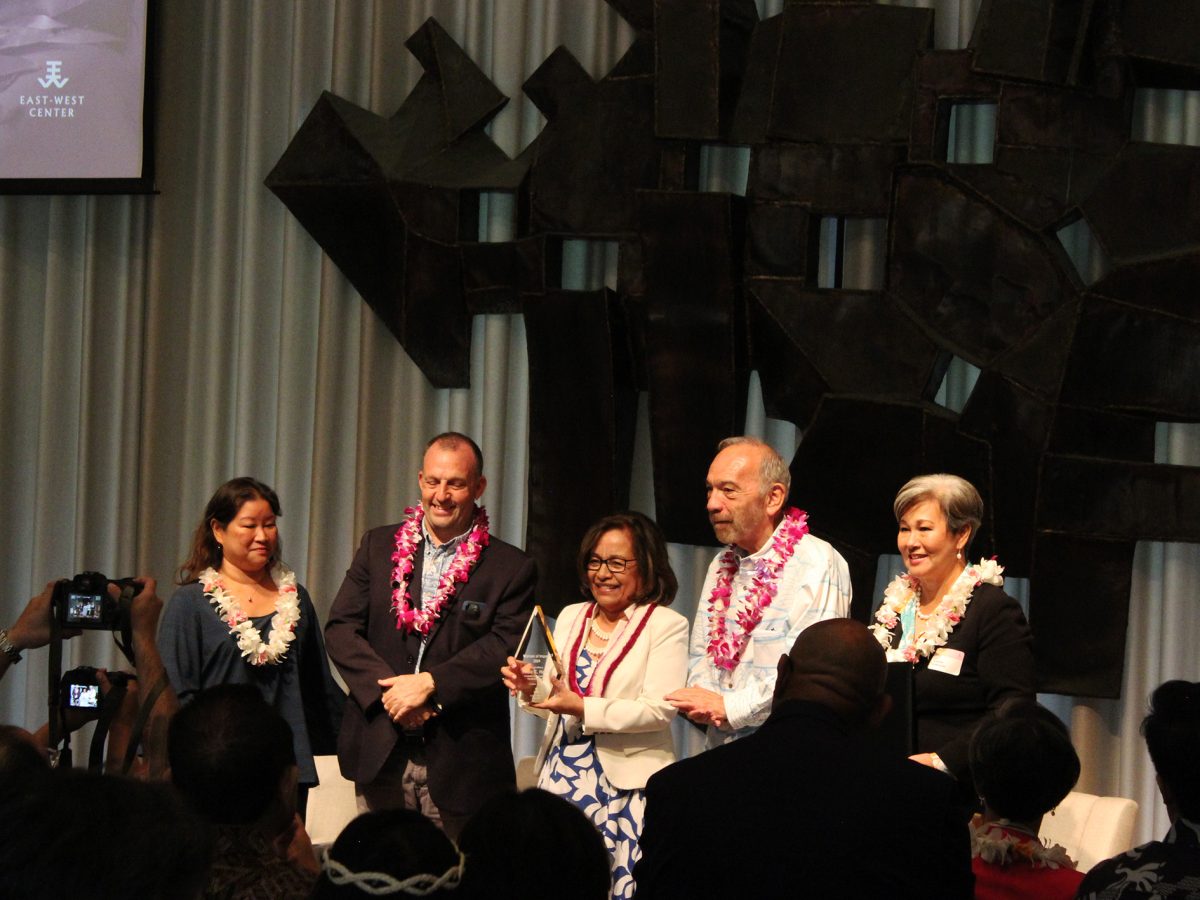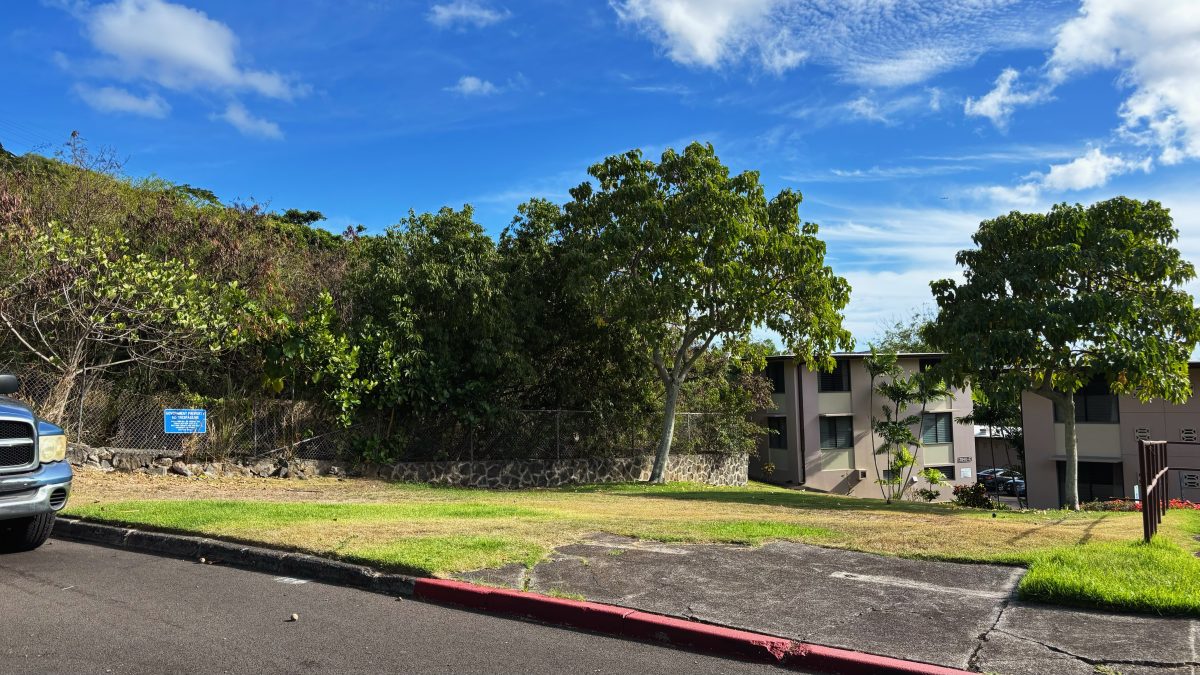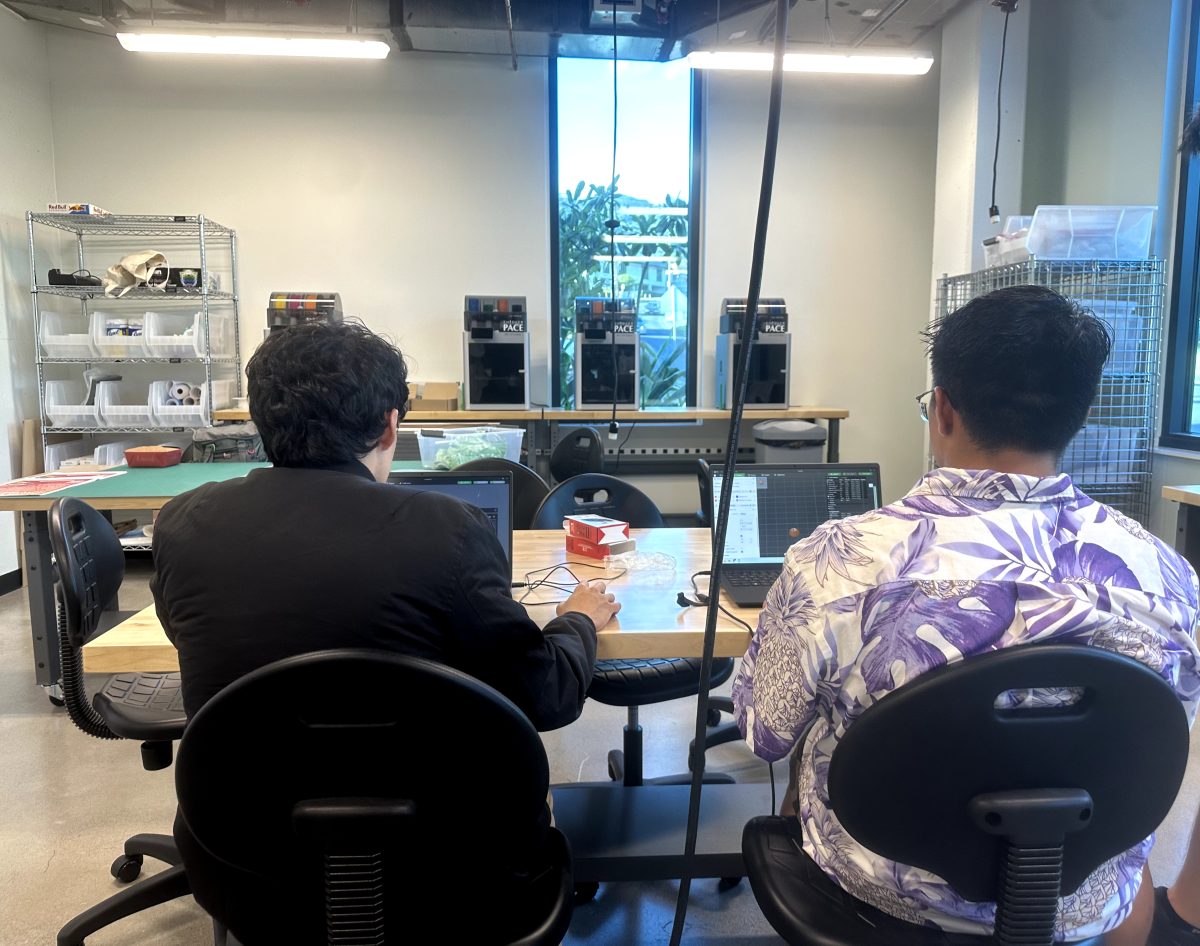Nestled within the heart of the University of Hawai’i at Mānoa campus, on the first floor of the Art Building, surrounded by ceramic and metal and wood workshops, is one of the university’s most distinctive amenties: The glass studio.
The adjoined academic program, established in 1968, is among the fewer than 30 glass programs at public universities nationwide. Students can work with cold glass, on grinders and polishers and saws, but the real attraction here, especially at night, are the red-hot glory holes, where glass gets blown, at more than 2,000 degrees, just about every night of the school year.
“If you want to work with glass in Hawai’i, this is really the only way to do it, by taking these classes,” said Ryan Mattie Wilson, a student in the program’s introductory course.
Claude Horan, who started the ceramics program at the university in 1947, also built the foundations of the glass program. Glass and Metal Professor, Richard Mills, became the driving force behind the retention of the glass program in the late 1980s, when there were threats to close it down. He has been holding that job steady since.
Originally from Marion, Ohio, Mills received his Bachelor of Fine Arts degree from The Ohio State University, where he focused on sculpting. It wasn’t until the summer after he graduated that he discovered his passion for the art of glass.
“I just fell in love with the material; it’s just so seductive and beautiful and difficult, dangerous,” Mills said. “I always loved fire; it’s scary and exciting and everything like that. And it’s not easy to do. It’s challenging but seductive.”
Mills later moved to Hawai’i, where he earned an MFA in glass and mixed media while working as a teacher’s assistant at UH. In his final semester at the university, Mills was informed by his instructor that the glass studio was at risk of closing down due to tenure issues and the lack of suitable instructors to keep it going. This motivated Mills to reach out to various organizations in the state for support in keeping the studio open.
“I didn’t know what I was doing but I just knew that you couldn’t close this area, there’s too much potential,” Mills said. “There’s too much camaraderie, too much good stuff going on. Why couldn’t this glass studio make it?”
Mills succeeded in his efforts and was later hired as UH’s lone glass professor in 1988. He was responsible for single-handedly running the glass program, and he has done much of that maintenance work in the three decades since, on top of the other classes he teaches, including metal fabrication.
During that time, he has expanded the glass program by introducing four additional courses to the foundational glass courses he inherited, ART 130 Introduction to Glass and ART 330 Advanced Glass.
The introductory course is open to all students at the university, with no prerequisites required.
“It’s a 100-level course, and at a lot of universities, you have to take foundations first for a year, then the next year you can come in and blow glass,” Mills said. “But I cast a broad net.”
Mills said that he has welcomed students from just about every major, and in one section of this semester, only three of the 12 registered students are art students.
“Most of my (glass art) majors don’t come from already declared art majors,” Mills said. “They change their major.”
One of those students is Jacob Barter, an undergraduate BFA glass student and a teacher’s assistant for Mills.
Originally an English major, Barter said he switched to a BFA in glass after taking the introductory course to fulfill his art credit.
“Glass and just, like, studio art in general gave me a certain amount of freedom I’ve never really experienced, ever, in my whole life,” Barter said. “I think it was the freedom that drew me to this program.”
An unusual aspect of the glass program, Barter said, is the camaraderie that typically is formed between students and faculty, particularly through the Glass Art Family Club. This optional club is open to all glass students and provides members with various activities and opportunities, whether it’s selling glass creations, having social events together or meeting and learning from visiting glass artists.
“I think the students and the employees, they all sort of form a big family,” Barter said. “And that’s what our glass club is called, it’s called the Glass Art Family because it’s unique in that way. It creates community.”
The UH Mānoa Glass Program also offers students plenty of opportunities for hands-on experience and skill development. Students have access to ample glass-blowing time, unlike many other programs across the nation, Mills said, where blowing is typically a separate track.
“Usually you don’t get blowing time if you’re in a non-blowing class,” Mills said. “But my students all get the same amount of blowing time. So they may be working 18 to 20 hours a week” on their glass creations.
While the UH Mānoa Glass Program offers various positive benefits to both the Art Department and the university as a whole, it also depends heavily on student participation. To keep the studio and program running, Mills said, there must be enough student enrollment each semester.
“Out of a class of 12, I gotta bring up at least a couple of students each semester” to the higher-level sections, Mills said. “There are two sections of it, one and two. So if I bring up two students each semester, that gets me eight students in the upper classes. Then, the studio survives.”
Art Department Chair and ceramics Professor Brad Taylor acknowledged that the number of students working toward a Bachelor of Fine Arts is typically low, especially in glass. This semester, in particular, only one student is earning a BFA in glass.
In addition, the glass program demands substantial financial resources, Mills acknowledged, with monthly costs totaling about $6,000, including supplies for the specialized equipment and the costs of the continuous operation of the furnaces. UH pays those expenses out of its general fund.
Each student also contributes a lab fee of $35, per class, plus an addition fee, per glass class; for example, students enrolled in Art 130 Introduction to Glass are charged an additional $275 each.
The Art department has regular sales of students work, with the glass group offering Mother’s Day and Christmas sales, taking a 40% cut from the proceeds to invest back into the studio. The glass area has received external grants as well, i.e., a $250,000 grant from the Cooke and Strong families to renovate the studio.
Besides covering basic operations, these funds bring in visiting artists, including more than 60 glass artists, during the past 30 years, with little or no direct expense to UH. Those visiting artists mostly donate the work they create during their stay as a way to support the next visiting artist.
The value of the glass program, in other words, Taylor said, equates to rich and unparalleled student experiences.
“I think that the resources to have people experience that in a physical way and not in a book,” Taylor said, “can influence the way that people think in ways that traditional study at the university can’t do.”
As the UH Mānoa Glass Program continues under Mills’ guidance, there also lingers a quiet contemplation of its future, with Mills nearing retirement age, several students acknowledged.
Amidst this long-term uncertainty, several students said, there remains a collective hope that the program’s contributions to the university experience will continue for generations to come.
“I would hope that as we move forward in time, it remains a key piece of what it is that we offer,” Taylor said. “I think glass has something, it has the ability to connect people.”
